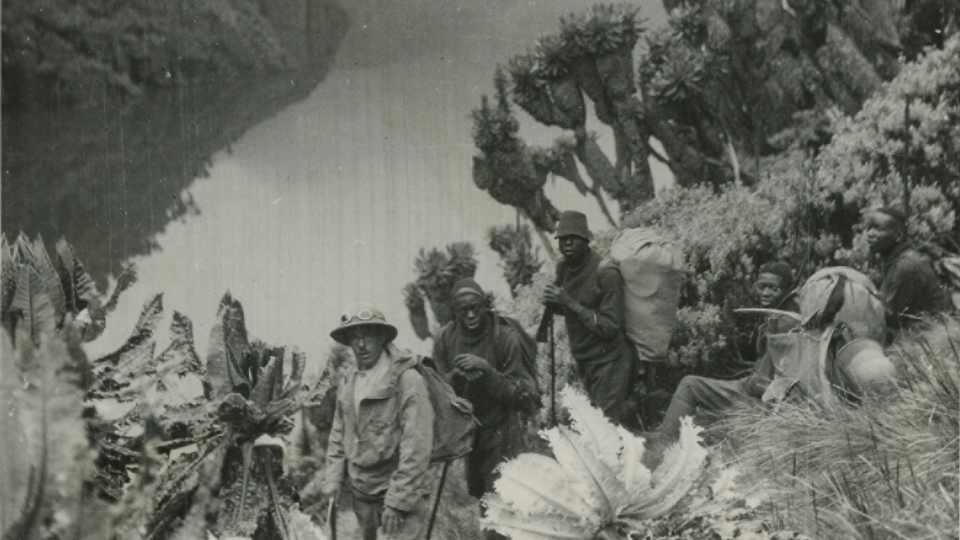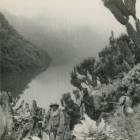When set up in 1925, the Albert National Park (ANP, later renamed the Virunga National Park) consisted of only 10,000 hectares in the eastern Kivu region of the Belgian Congo. Initially conceived mostly as a sanctuary for the mountain gorilla, the park’s territory was largely mapped onto the habitat of this one charismatic species. Over the next decade, however, the ANP expanded substantially. By the early 1930s it boasted a size of no less than 856,790 hectares, including expansive steppes and savannahs, marshlands and forest belts, as well as volcanoes with unique Afro-alpine vegetation.

The Albert National Park started out as a sanctuary for the mountain gorilla—a charismatic species that still constitutes one of the major draws of the present-day Virunga National Park.
The Albert National Park started out as a sanctuary for the mountain gorilla—a charismatic species that still constitutes one of the major draws of the present-day Virunga National Park.
Photograph by Luanne Cadd.
 This work is licensed under a Creative Commons Attribution-ShareAlike 3.0 Unported License.
This work is licensed under a Creative Commons Attribution-ShareAlike 3.0 Unported License.
The park’s foundation and subsequent expansions were initiated by a small network of individuals, the composition of which is important to understanding the ANP’s management philosophy. The Belgian king Albert I and his son Leopold (later Leopold III) were involved, alongside a transnational group of aristocrats, diplomats, and naturalists. These men and women largely shared the same class background, as well as an interest in the outdoors, big-game hunting, scientific collecting, and (more progressively) nature protection. It was ultimately a coalition of the immediate confidantes of the royals, Belgian associations for colonial zoology, American natural history museums and hunter’s clubs, and international nature-protection societies that managed to create the necessary clout for the establishment of the park.
During its foundational years, the promoters of the ANP consistently presented the park as a place of scientific research and international collaboration—a rhetoric I have explored in a recent article in Environmental History. Depicted as a “natural laboratory,” it was intended not only to serve Belgian researchers, but scientists from across the globe. One American newspaper captured this when, in the 1930s, it described the ANP as “an interesting experiment in internationalism.” Journalists and science popularizers, as well as the ANP’s managers themselves, framed the region as an area of universal scientific interest—because its nature was “primitive” and “untouched,” “isolated” and “varied,” and because it could provide researchers with a “microcosm” of Edenic Africa as a whole.
While American national parks definitely served as an example, the ANP did not echo their ambition to enable the tourist consumption of spectacular landscapes. Rather, it was modeled after the Swiss National Park, a “strict nature reserve” where scientists have to get permission to study its fauna and flora under “natural” conditions. This ambition was also reflected in the institutional makeup of the ANP. The Park’s director was always a scientist—first the zoologist Jean-Marie Derscheid, later the geologist Victor van Straelen. The director did not report to the local colonial authorities, but served directly under the Minister of Colonies in Brussels. As such, the ANP was often perceived as constituting a state within a state. Its largely independent administrators were advised by an administrative commission composed of an international group of scientists and preservationists. This network guarded ANP’s “strict” preservation regime and also promoted it as a model to be applied in other imperial contexts.
Although the ANP eventually allowed tourist activity in some designated areas, its infrastructure mainly catered to the international scientific community. As Congolese historian Joseph Nzabandora and others have shown, the local population was increasingly denied residence in the ANP, as well as blocked from using its natural resources. To “restore” the primitive character of the region, the park administration set up eviction schemes, heavily affecting the local Banyarwanda (both Hutu and Tutsi), Nande, and Hema population. An exception was made for the Batwa (or “Pygmies” in the anthropological language of the time), who were framed as part of the “pristine” natural equilibrium and who were seen as subjects of scientific interest themselves. They were allowed to stay and occasionally hired as guards or guides.
The “scientific” conception of the ANP as a “strict reserve” was continuously challenged, however. The evicted populations resisted the ANP’s schemes and often intruded on its grounds. The Batwa for their part refused to live up to the role of “noble savages” and they rebelled against the administration’s attempts to control and regulate their activities. The governor general of the Belgian Congo, finally, often clashed with the ANP’s administrators, trying to wrestle back control over how the park was run.
Congolese independence in 1960 drastically changed the position of the ANP and that of the other national parks in the country. Yet, there were also clear continuities. Transnational networks of preservationists perpetuated the old discourse in which the ANP was presented as an unrivalled natural laboratory and a place of universal value. This rhetoric served to lobby for continued foreign expert rule in the park, which now would be partially paid for and directed by international organizations and NGOs. Despite the Africanization campaign by President Mobutu Sese Seko, as part of which the park’s name was changed to Virunga National Park in 1969, international involvement remained prevalent over the next decades. Political ecologists such as Esther Marijnen indicate that this has strengthened the idea among many in the region that Virunga continues to be “a state within a state.” In the past two decades, with the region under the spell of a violent civil war, international involvement and sponsorship has fuelled an increased use of military and paramilitary technologies and partnerships in the park. As such, Virunga is no longer solely a symbol of conservation’s internationalism, but also has become a well-known case of “green militarization.”
How to cite
De Bont, Raf. “Internationalism in the Heart of Africa? The Albert National Park / Virunga National Park.” Environment & Society Portal, Arcadia (Summer 2018), no. 16. Rachel Carson Center for Environment and Society. doi.org/10.5282/rcc/8359.
ISSN 2199-3408
Environment & Society Portal, Arcadia
 This work is licensed under a Creative Commons Attribution 4.0 International License.
This work is licensed under a Creative Commons Attribution 4.0 International License.
2018 Raf De Bont
This refers only to the text and does not include any image rights.
Please click on an image to view its individual rights status.
- De Bont, Raf. “A World Laboratory: Framing the Albert National Park.” Environmental History 22, no. 3 (2017): 404–32.
- De Bont, Raf. “‘Primitives’ and Protected Areas: International Conservation and the ‘Naturalization’ of Indigenous People, Ca. 1910–1975.” Journal of the History of Ideas 76, no. 2 (2015): 215–36.
- Marijnen, Esther. “Public Authority and Conservation in Areas of Armed Conflict: Virunga National Park as a ‘State within a State’ in Eastern Congo.” Development and Change 49, no. 3 (2018): 790–814.
- Nzabandora, Joseph. “Les Leçons des Conflits entre Communautés Locales, Administration Coloniale et Conservateurs au Sujet du Parc National Albert, Actuel Parc des Volcans Virunga (1925–1947).” Scientific Review of Kigali Independent University 21 (2011): 5–46.
- van Schuylenbergh, Patricia. “De l'Appropriation à la Conservation de la Faune Sauvage: Pratiques d'une Colonisation: Le Cas du Congo Belge (1885–1960).” PhD diss., Université catholique de Louvain, 2006. 543–777.










